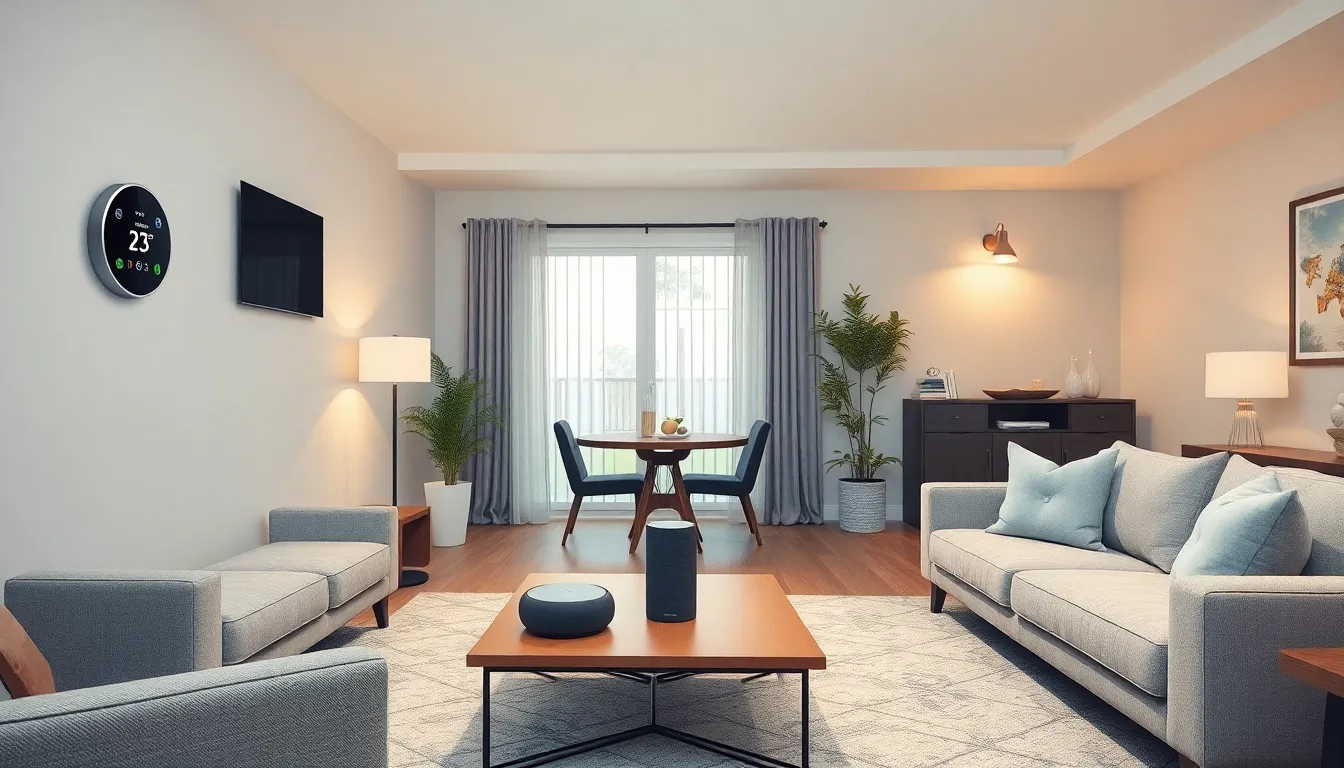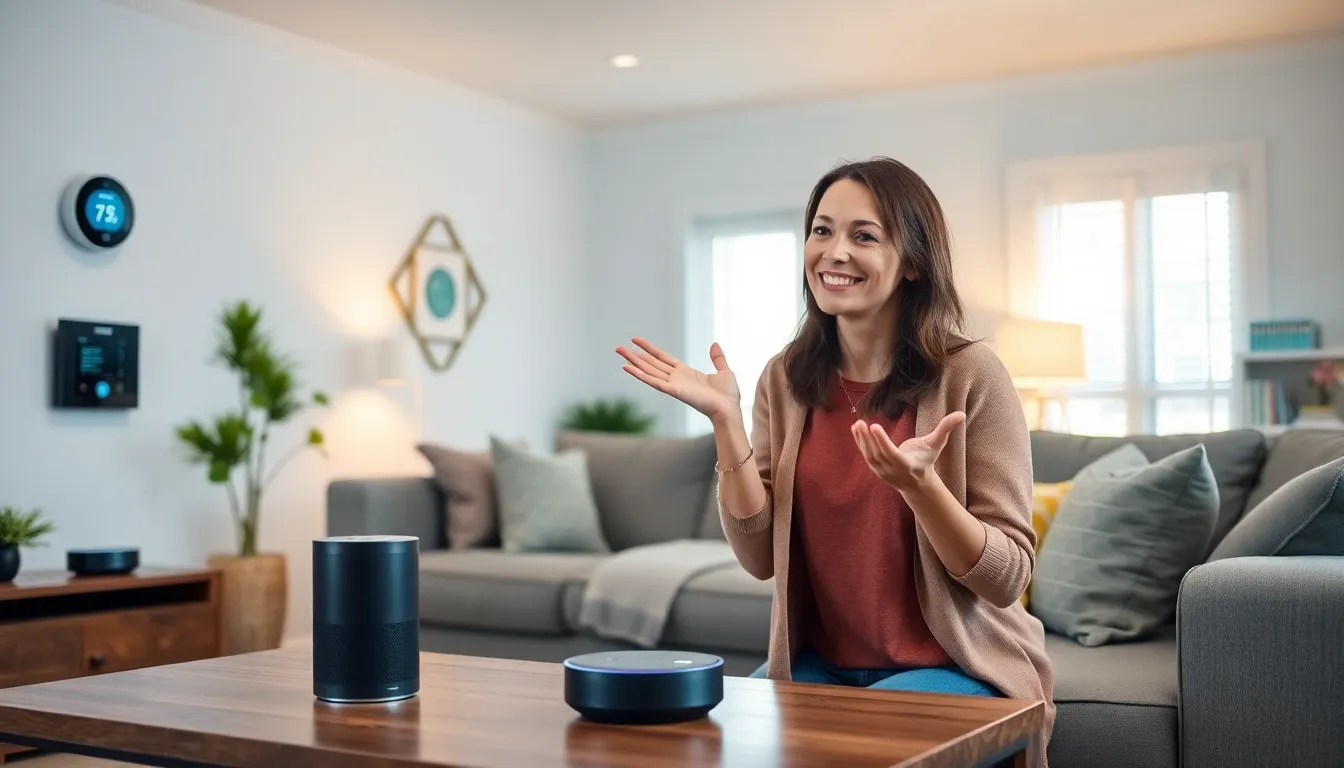Imagine walking into your home and having it greet you like an old friend. Lights flicker on, the thermostat adjusts to your favorite temperature, and your coffee maker starts brewing your morning fix—all without you lifting a finger. Welcome to the world of smart home integration, where technology transforms everyday living into a seamless experience.
Table of Contents
ToggleOverview of Smart Home Integration
Smart home integration enhances daily living through automation, providing convenience and control. Homeowners connect devices, creating a seamless network that manages tasks like lighting and temperature. Smart speakers, for instance, facilitate voice commands to control various functions.
Automated systems promote energy efficiency, reducing utility bills while increasing comfort. Many smart thermostats learn from user behavior, adjusting temperatures based on preferences. Sensors that detect occupancy can turn lights on or off, maximizing efficiency further.
Smart home security features help safeguard properties. Cameras, motion detectors, and smart locks enable homeowners to monitor access remotely. Notifications sent to smartphones keep users informed of potential threats.
Interoperability plays a crucial role in the smart home ecosystem. Devices from multiple manufacturers often communicate, creating customized experiences. Compatibility is essential for maximizing the benefits of smart home technology.
Smart home platforms provide central control over various devices. Homeowners can use a single app to manage everything from heating systems to kitchen appliances. The result is an integrated lifestyle that promotes simplicity and ease of use.
Smart integration also supports lifestyle enhancements, such as personalized settings for different times or activities. For example, “movie mode” can dim lights and adjust sound systems with a single command. Customization enhances convenience, making daily routines more enjoyable.
Integration of smart technology not only simplifies tasks but also improves overall quality of life. Adopting smart home solutions can lead to significant changes in how spaces are used, making life easier for all occupants.
Benefits of Smart Home Integration

Smart home integration offers numerous advantages that elevate daily living. It transforms convenience, enhances energy efficiency, and bolsters security.
Convenience and Automation
Smart home devices streamline daily tasks. Automated lighting adjusts as occupants enter rooms, while smart speakers respond to voice commands to control various functions. Temperature settings adapt based on user preferences, offering comfort without manual adjustments. With apps centralizing control, managing multiple devices becomes simple. Customizable routines enhance mornings or evenings by automating coffee brewing or adjusting the thermostat. Overall, convenience and automation work together to improve users’ experiences and simplify everyday life.
Energy Efficiency
Energy efficiency remains a primary benefit of smart home integration. Smart thermostats learn behaviors to optimize heating and cooling, leading to significant savings on utility bills. Lighting systems automatically turn off when rooms are unoccupied, conserving energy. Homeowners can monitor energy usage through their smartphone apps, enabling informed decisions. Smart appliances run during off-peak hours, contributing further to cost savings. Collectively, these features promote sustainable living while reducing environmental impact.
Enhanced Security
Enhanced security features are vital components of smart home integration. Smart locks provide keyless entry and can be locked or unlocked remotely. Surveillance cameras allow homeowners to monitor properties in real-time, alerting them to unusual activity. Motion sensors trigger notifications, offering peace of mind even when away from home. Centralized control through a single app simplifies management of security devices. This integration ensures safety measures are always within reach, reinforcing the overall security of the residence.
Key Technologies in Smart Home Integration
Smart home integration relies on several key technologies that work together to create a cohesive environment. These technologies include Internet of Things (IoT) devices, voice assistants, and smart hubs.
IoT Devices
IoT devices play a critical role in smart home ecosystems. These devices connect to the internet and communicate with each other, enabling automation. Examples include smart thermostats, security cameras, and smart lighting. With IoT devices, homes can adapt to user preferences and operate efficiently. These tools automatically monitor energy usage and adjust accordingly, encouraging energy savings. They enhance daily routines by acting on commands via mobile apps, providing seamless integration.
Voice Assistants
Voice assistants serve as the primary interface for interacting with smart home systems. Users issue commands through devices like Amazon Echo or Google Home, making daily tasks easier. These assistants control various smart devices, enabling hands-free operation. For instance, a simple voice command can adjust the thermostat or turn on lights. Voice recognition technology continues to improve, enhancing speed and accuracy. Integration with IoT devices allows voice assistants to execute complex routines, such as “goodnight” commands that secure the home and dim the lights.
Smart Hubs
Smart hubs act as central control units for connected devices. These hubs simplify management by allowing diverse devices from various manufacturers to work together. A unified platform minimizes the need for multiple apps, enhancing user experience. Examples of popular smart hubs include Samsung SmartThings and Apple HomePod. Smart hubs facilitate automation by enabling users to define routines and set schedules. They ensure interoperability among devices, contributing to a holistic smart home environment.
Challenges of Smart Home Integration
Smart home integration offers numerous advantages but also presents challenges that users must navigate. Several key issues affect the seamless operation of smart devices.
Compatibility Issues
Compatibility among devices often complicates smart home integration. Many smart devices rely on different communication protocols, resulting in limited interoperability. Users may find themselves with multiple apps for different systems, leading to frustration. Manufacturers sometimes develop devices using proprietary technology, creating barriers for seamless connectivity. The lack of standardization further exacerbates these issues. Successful integration requires selecting devices that can communicate effectively or investing in hubs that unify control.
Security Concerns
Security remains a critical challenge in smart home integration. Vulnerable devices can serve as entry points for cyberattacks, putting personal data at risk. Weak default passwords and outdated firmware amplify security threats. Unauthorized access can lead to privacy breaches and safety risks for homeowners. Regular security updates and the use of strong passwords can mitigate some of these risks. Manufacturers are increasingly focusing on building more secure devices to address these concerns in the evolving market.
User Privacy
User privacy poses significant concerns in the smart home landscape. Many smart devices collect vast amounts of personal data to deliver personalized experiences. This data collection raises questions about how information is stored and shared. Users often lack clear visibility into their data handling practices, leading to potential misuse. Smart device owners must take proactive measures, such as reading privacy policies and adjusting settings to limit data sharing. Ensuring privacy in a connected home is essential for maintaining user trust and comfort.
Future Trends in Smart Home Integration
Smart home integration trends are rapidly evolving, enhancing user experiences across various dimensions. Increased adoption of artificial intelligence stands at the forefront of these advancements, enabling devices to learn user behaviors and preferences over time. Voice control technology continues to advance, allowing for more natural interactions between humans and machines, promoting seamless operation.
The growing emphasis on energy efficiency drives innovation in smart devices, with manufacturers focusing on environmentally friendly solutions. Companies are now producing smart appliances that optimize energy consumption, which not only reduces costs but also minimizes environmental impact. Advanced data analytics plays a significant role in monitoring energy usage patterns, providing insights that encourage efficient habits.
Robust security measures continue to gain importance as smart home systems become more prevalent. Enhanced encryption techniques and multi-factor authentication standards are developing to safeguard against potential cyber threats. Users increasingly prioritize systems that offer real-time alerts and automated responses to security breaches, ensuring peace of mind.
Interoperability among devices from different manufacturers remains essential. Prominent players in the smart home market are collaborating to create standardized protocols, making it easier for consumers to build integrated ecosystems. Consumers benefit from platforms that offer unified control, allowing them to manage devices from a single interface.
Customizable experiences are on the rise, prioritizing user preferences in various scenarios. For instance, dynamic modes enable users to adapt their home environment for specific activities, such as relaxing or entertaining. This personalization enhances convenience and optimizes the atmosphere within the home.
The future of smart home integration centers on enhancing comfort, security, and sustainability. As technology progresses, automated systems will continue to redefine daily living, creating environments that anticipate and respond to individual needs.
Smart home integration represents a significant leap forward in how people interact with their living spaces. By automating daily tasks and enhancing security, it transforms homes into responsive environments that cater to individual needs. The seamless connectivity of devices not only simplifies management but also promotes energy efficiency and sustainability.
As technology continues to evolve, the future of smart homes looks promising. With advancements in artificial intelligence and voice control, users can expect even more intuitive experiences. Prioritizing interoperability among devices will further enhance customization and user satisfaction. Embracing smart home integration will undoubtedly lead to a more convenient and enjoyable lifestyle for everyone.




